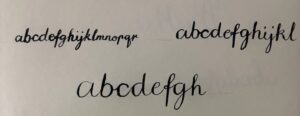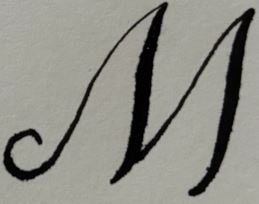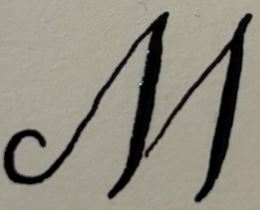Getting the hang of it!
The right tools can make all the difference in any craft, whether it’s art or mechanics. Just as a digital torque wrench ensures precision by beeping when the correct tightness is reached, calligraphy tools shape the quality of each stroke. In my pursuit of refining my calligraphy tools, I experimented with transforming a traditional Persian reed, or Qalam, into a makeshift nib pen. Though the process was intriguing, the results were far from ideal. The reed lacked the precision and consistency I desired, leading me to appreciate the superior craftsmanship of the copperhead nib. Its smooth ink flow and crisp strokes outshone my handmade attempt. Additionally, I found that the quality of the paper played a crucial role in the outcome, with smoother, high-quality paper allowing for better ink distribution and sharper lines. The size of the writing also mattered; larger letters revealed more of the perfections in the strokes. The copperhead nib maintained clarity when I tried to write in a little bigger size. To document this journey, I divided this time blog into two sections about the size and the paper quality, showcasing the process, the challenges I faced, and the ultimate comparison between the two tools.
Size of Writing
I wasn’t satisfied with the precision of my lettres when I compared my work with the samples. I then ran into a Youtube video explaining how the size affects the precision that helped me figure out that when I write in larger sizes, I gain more control and precision for several reasons:
1. More Room for Error Correction – With larger letters, small inconsistencies are less noticeable, allowing you to make finer adjustments to strokes without ruining the overall form.
2. Greater Hand Movement Control – Larger writing engages your whole arm and shoulder rather than just your fingers and wrist. This allows for smoother, more controlled strokes, reducing shakiness.
3. Easier Visualization of Proportions – When writing larger, it’s easier to see the relationships between strokes, curves, and spacing, leading to better balance and symmetry.
4. Better Tool Responsiveness – Many calligraphy tools (e.g., brush pens, broad nibs) respond better to wider, more deliberate movements, creating cleaner and more expressive strokes.
5. Less Cramping and Tension – Small, tight movements can lead to muscle tension, making precision harder. Writing larger reduces strain and allows for more fluid motion.
This is why professional calligraphers often practice at a large scale before refining their skills for smaller lettering. Here you can see different attempts:


Paper Quality
After a while practising on standard cartridge paper, I noticed that smoother paper, like the Strathmore Drawing 80lb, allows nibs and brush pens to glide more effortlessly, resulting in cleaner strokes and less ink feathering. I gave it a try and at the very first seconds, I felt the big difference.
Standard cartridge sketch paper and Strathmore Drawing 80lb paper have notable differences, especially for calligraphy:
1. Surface Texture (Tooth)
• Cartridge Sketch Paper: Typically has a rougher texture with more noticeable tooth, designed to grip dry media like pencils and charcoal. This can cause ink to feather or spread unpredictably.
• Strathmore Drawing 80lb: Smoother surface with less tooth, allowing pen nibs and brush pens to glide more easily, resulting in cleaner, more controlled strokes.
2. Fiber Composition
• Cartridge Sketch Paper: Contains more visible fibers, which can cause ink to bleed and snag fine nibs.
• Strathmore Drawing 80lb: Has a more compact fiber structure, reducing ink absorption and feathering.
3. Ink Absorption & Bleeding
• Cartridge Sketch Paper: Absorbs ink more readily due to its porous nature, leading to potential bleeding and less crisp lines.
• Strathmore Drawing 80lb: More controlled absorption, minimizing ink spread and improving line sharpness.
4. Durability & Weight
• Cartridge Sketch Paper: Usually ranges from 50–70lb, making it thinner and more prone to warping with wet media.
• Strathmore Drawing 80lb: Heavier weight provides better durability and resistance to warping, making it more suitable for ink-based work.
5. Best Uses
• Cartridge Sketch Paper: Ideal for dry media (pencil, charcoal) and rough sketches but not the best for calligraphy.
• Strathmore Drawing 80lb: Works well for calligraphy, pen and ink, and light washes due to its smoother finish.
If you enjoy smoother, bleed-resistant paper for calligraphy, Strathmore Drawing 80lb is definitely the better choice.
Here you can see the difference comparing these two capital M lettres on two different paper and how the ink feathers on the left hand standard cartridge paper.


Do you think the tools really matter?
I appreciate your commentary on not only learning a skill, but ensuring you have the proper materials. I agree that tools matter when learning various skills. From my own experience, using anything but watercolour paper with watercolours is a nightmare! Thank you for sharing!
I love the progress! I appreciate you sharing every step and detail you’ve learned. Materials matter everywhere! I can’t wait to see what you do next!
These writing samples look amazing! At first I thought that your writing was a professional photo that you were using for inspiration. It is clear to see that putting in the time for those extra details is paying off for you. Keep up the great work!